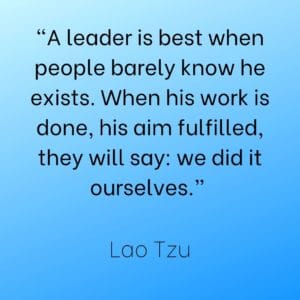
You may remember an amazing boss or manager in your life because they made a positive difference. Terrible leaders often remain etched in memories, too, sometimes for being too lax or rigid. When you want to hone your leadership skills, reflecting on past managers may be a source of inspiration as you try to pin down a style. However, one leadership style will not necessarily meet all the goals of the team or company. Often, a combination of leadership styles works best, but everyone differs.
Here are some common types of leadership styles:
- Transformational Leadership:
Transformational leaders work with the team, putting their self-interests aside. This style motivates the group while everyone works towards the same goal. Transformational leadership works well to tap into the potential of the team. However, in larger groups, a transformational leader may lose oversight of individual team members.
- Servant Leadership:
In the 1970s, Robert Greenleaf termed the style servant leadership, where leaders prioritize their team first. Servant leaders have no self-interest or gain, and their style focuses on others before themselves. Servant leadership styles take time to build and do not work in all organizations.
- Strategic Leadership:
Strategic leaders balance the company’s interests along with those of its employees. Although a compelling style, strategic leaders sometimes have to place the company or team as a priority. An imbalance can send mixed messaging and de-motivate employees.
- Democratic Leadership:
An effective democratic leadership style seeks input from all levels of staff to make a decision. Every employee, regardless of rank, carries the same weight as the democratic leader considers all feedback. However, the decision-making may be overturned by upper management or board members, which can deflate employees. The opposite style is autocratic leadership, which does not serve any company well. Autocrats make all the decisions regardless of rank. Bureaucratic leaders strictly follow all the rules and can be deemed heartless. Regardless of the situation, bureaucrats will go by the book with the company’s policies at all times.
- Transactional Leadership:
Transactional leadership is quite common and involves an employee getting a reward upon completion of work. Transactional leaders offer incentives, which motivate employees, yet can have short-term effects. This type of leadership style works well in some settings, but employees may feel unappreciated and dehumanized.
- Authoritarian Leadership:
Setting clear expectations and goals with defined deadlines defines authoritarian leadership. This style works well to accomplish projects or tasks but may be viewed as micromanagement by employees. Authoritarians typically see higher turnover rates and diminished group morale.
- Laissez-Faire Leadership:
Also known as delegative leadership, laissez-faire can be defined as the team being self-directed. Employees may love the independence and the positive work environment. However, objectives are not always clearly defined, and this may create tension amongst the staff. Laissez-faire leaders also have limited abilities to adapt and difficulty adjusting to change.
- Coach-Style Leadership:
Coach-style leadership treats the staff as a team through collaboration and strategy for “wins.” A coach-style leader will focus on team members’ strengths and utilize them while offering support. This leadership style does not foster opportunity or growth; how often does a quarterback play on the defensive line?

As you familiarize yourself with some common leadership styles, flexibility is vital to becoming an outstanding leader. John Heider wrote, The Tao of Leadership in 1985, which looks at leadership and gets readers, or leaders to reflect. This guide has been a vast yet profound resource for leaders over the past 36 years.
Heider discusses possessing self-awareness, which can help you develop a unique leadership style based on your strengths. Acknowledging your weaknesses and working on them also builds stronger leadership traits. A wise leader understands human behavior, utilizes practicality, and implements various strategies. Knowledge is power when customizing your leadership style. Sharpen your skills and seek a mentor, read materials, train, and always learn as much as you can.
